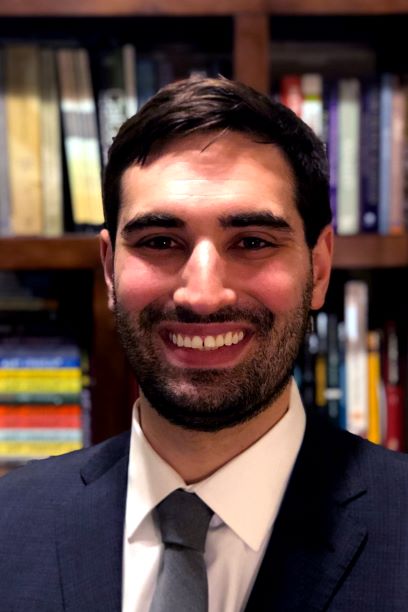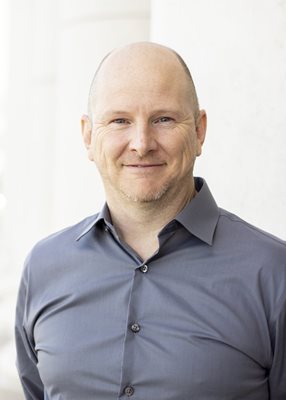News
Doctoral Graduate’s Research Opens the Door to Better Battery and Computing Technologies
Justin Andrews' research focuses on making new materials to help science fight climate change
By Rob Dixon, Texas A&M University Graduate and Professional School
.jpg)
COLLEGE STATION, June 15, 2021 – Texas A&M’s 2021 Distinguished Dissertation and George W. Kunze Award winner Justin L. Andrews begins his dissertation with a stark warning. In 2018, before the COVID-19 pandemic made us even more reliant on digital communication, data centers accounted for around 1% of global energy consumption. “Alarmingly,” Andrews writes, “the volume of data collected annually is projected to skyrocket about a millionfold by 2040.”
Such a dramatic increase in the amount of energy required to process and collect data, according to Andrews, has serious potential consequences. That’s because, he explains, powering computers and data storage servers requires the production of more energy, which accelerates climate change and creates environmental conditions that make dangerous events, such as forest fires and extreme weather, more likely.
“I don’t know that I’ll see the worst of it in my lifetime, but I know kids growing up today will,” said Andrews, who has a young child. It’s really imperative that we do something. And I don’t think we can change the way we live drastically enough to reverse current trends. It’s really up to science to come up with game-changing solutions.”
Altering the Chemistry
The “game-changing solutions” Andrews is calling for include two main areas of focus, both of which require more than re-engineering existing technologies or working with known chemical compounds. The first is to make new materials that would open the door to improved efficiency in computing. The second is to think beyond lithium-ion batteries for energy storage.
Andrews explains that we have basically maxed out silicon-based computing capabilities and lithium-ion batteries. “Think about how great these technologies have been. Amazing right?” he said, animated by exuberance for his subject. “They have both enabled us to process information on smaller and smaller mobile devices, but we’re running out of room on silicon chips and pushing lithium-ion performance any further will introduce safety risks.”
For an alternative to lithium-ion batteries, scientists have turned to magnesium. Theoretically, magnesium can work, Andrews explains. “Metallic magnesium is not only safer than metallic lithium, but it also promises significant improvements in terms of capacity as an electrode. One problem is that there’s no existing cathode—the negative to the electrode’s positive—that works with it,” he said.
Developing a cathode that would pair well with magnesium ultimately requires imagining entirely new compounds, a feat that has so far stymied scientists. That’s because, Andrews explains, “traditional techniques used to make these compounds—like heating to high temperatures—causes the atoms of the compound to become unstable and rearrange themselves in a way the scientist doesn’t intend.”
As a remedy, Andrews has developed a framework to stabilize these so-called “metastable” compounds so that scientists can study and experiment with them. He uses an analogy to explain how this works.
“I get to play chemical Jenga in the lab all day,” he says. “Imagine that you take a bunch of elements and put them in a glass container and heat them up to really high temperatures. The way they coalesce tends to be predetermined by thermodynamics, so there’s a fixed position they fall into in. Now imagine that as a tower. My research makes it possible to start with the predetermined tower but then very precisely choose which “blocks,” or atoms, to remove without triggering the collapse of the tower, or chemical compound, so you can rearrange the blocks to create your dream tower, or a different compound that works in an entirely new way. That has been impossible to do, previously,” he said, “which is really cool. It’s literally changing the chemistry.”
Not only could his research lead to the design of a cathode to pair with the magnesium electrode to create a new type of battery, the same applications could be used to create materials for neuromorphic, or brain-inspired, computing. “In effect, we can develop new materials to make computers more efficient and better at adaptive learning, pattern recognition, optimization and classification,” Andrew said. “Improving computing capabilities in these areas is crucial if, for example, we’re going to have self-driving cars navigate rush hour traffic in Houston.”
The brain-inspired computing project was something Andrews worked on as part of an X-Grant team. Funded by Texas A&M President’s Excellence Fund, the X-Grant program brings together researchers from different disciplines to address the most important challenges facing the world today.
Andrews says that working on the interdisciplinary X-Grants project represents an example of how researchers working together from across a variety of fields enables innovation.
“Chemists may sometimes get ultra-focused on what properties we think a material needs, but materials scientists and electrical engineers down the pipeline have a totally different perspective. The X-grants program put us all in the same room and really helped to inform the chemistry and materials design in a practical way. This is a really promising way to do science because it helps us concentrate our efforts on what it takes to make something like brain-like computing a reality much faster than if we worked in silos.”
From the Classics to Chemistry
Helping create innovations in chemistry while earning a doctoral degree from Texas A&M was an unlikely destiny for Andrews. Not only is he a first-generation college student, he graduated as one of only thirteen students in his senior class from Hill Country Christian School of Austin, where his chief academic interests were classical languages. After that, he began attending Gordon College, a small Christian liberal arts school in the northeast, as a Classics major.
“I was really into the classics in high school,” Andrews explained. “I traveled throughout Texas competing in Latin and Greek quiz bowls and it was really fun, so that’s what I wanted to continue studying in college,” he said.
At Gordon, where students can’t major in chemistry and research opportunities are limited, he took a science class as part of a liberal arts core requirement. During the unit on organic chemistry, he was hooked.
Andrews explains that this is less of a dramatic turn than it seems, because he is drawn to problem-solving as an intellectual pursuit. “As weird as it sounds, a process in organic chemistry called ‘retrosynthetic analysis’ reminded me of deconstructing sentences in Latin, where there’s a different structure than we’re used to,” he said. “The problem-solving aspect of it appealed to me.”
During his junior year, as a participant in a National Science Foundation-sponsored “Research Experience for Undergraduates” (REU) program, which provides funding for undergraduate students to participate in research projects at host institutions, Andrews got the opportunity to spend the summer before his senior year at Texas A&M working in Professor David Bergbreiter’s research lab. “It was my first real chance to do research,” he said. “It was an amazing experience working in Dr. Bergbreiter’s lab and it really opened the door for me to chemistry and graduate school.”
Texas A&M placed high on his list when Andrews applied to graduate programs the next year. “I connected with people in the department and was really impressed with the research they were doing,” Andrews said. The following fall, he began graduate studies in the Texas A&M Chemistry Department and was awarded a NASA Space Technology Research Fellowship in his second year.
Andrews believes that his liberal arts background gives him a different perspective on science and instills in him a sense that collaboration, not just among those in STEM fields but also between science and the humanities, generates ideas and innovation that improve the world.
“My favorite class in undergrad was ‘Science and Literature,’” Andrews said. “In that class we read The Two Cultures by C.P. Snow. The book highlights the division of education into two distinct and separate cultures: science and the humanities. The lack of conversation between the two “cultures” in our educational system often means that we as a society are ill-equipped to tackle problems related to science at the level of government where decisions are often made. That’s obviously an issue we’re running into today. We have too many lines drawn when we could solve more problems by working together,” he said.
Banerjee Research Group
Sarbajit Banerjee Research Group (Andrews top row, right of center)
As a doctoral student at Texas A&M, Andrews worked in the lab of Sarbajit Banerjee. Banerjee joined Texas A&M in 2014, the same year Andrews began his doctoral program. It was a serendipity, Andrews explains.
“I was wholly unaware that he was going to be there, but it changed everything for me because I just fell in love with the research he was doing,” Andrews said. “In his lab, we were not just focusing on making new materials and understanding at a fundamental level what they do. We were exploring the real-world applications and it was exciting to know that our work could have an impact.”
Andrews praised both the design of the doctoral program in the Department of Chemistry and the mentorship of Banerjee, who also directed the X-Grant project Andrews worked on. “The thing I loved most about the program at Texas A&M was that it’s just one year of coursework, then you work in a lab. That’s great because we all know the fundamentals and the equations, but true innovation is not just about taking someone else’s technique and applying it. You have to get into the lab and chart your own course.”
Andrews has, according to Banerjee, excelled in the lab. “Justin has worked out a remarkable new approach to stabilize metastable compounds, which will have tremendous implications in a number of different technologies, including brain-inspired computing, solar photocatalysis, and non-lithium ion batteries. Many research groups with orders-of-magnitude more resources have not been able to do what Justin has done. He has published prolifically, his research is already influencing other research and commercial ventures, and he launched several new directions for my research group. But not only is he a brilliant researcher, he is tremendously creative, has a great work ethic, and is a model citizen.”
What’s Next for Andrews
Andrews is currently a post-doctoral researcher at MIT, where he is working with metal organic frameworks for use in supercapacitors. This work is a departure from what he was doing at A&M—mostly working with transition metal oxide materials for battery and computing applications. “I’m still looking to advance energy storage capacities,” he says, “but the different materials I’m working with require an almost entirely new skill set. It’s a new challenge.”
But it’s a challenge Andrews feels his research experience at Texas A&M has readied him for. “I know I had a lot of success in graduate school, but I had no publications for the first three years. When I felt I had nothing to show for all the work I was putting in, Dr. Banerjee kept pushing me in the right ways to keep me motivated, so I learned patience and resilience,” he said. “As a scientist, nine out of ten times when you conduct an experiment that no one has ever thought of before you are going to fail, but you have to stay excited and keep trying things, no matter how crazy they may seem, so I’m prepared for that and happy that I have another opportunity at MIT to broaden my horizons and learn new skills.”
In addition to continuing to learn how to help solve the world’s energy crisis and address global warming, Andrews hopes someday to land a faculty position at a research university, where he can run his own lab and mentor young scientists. “That’s where I can make the biggest difference—with my research and in students’ lives.”
###
Media contact:
Rob Dixon, Texas A&M University Graduate and Professional School
979.845.3631
rdixon@tamu.edu
